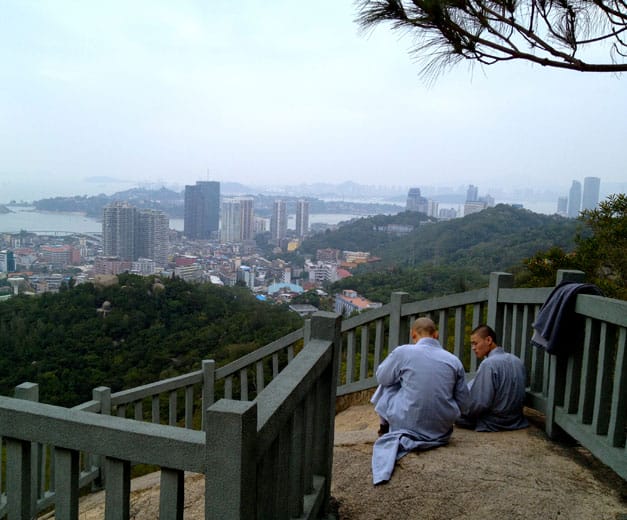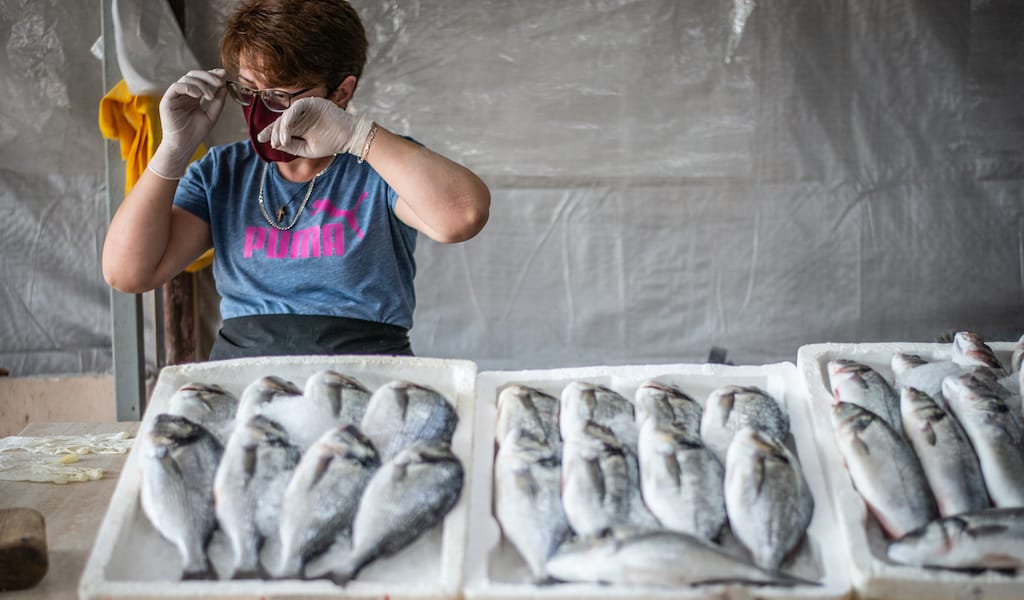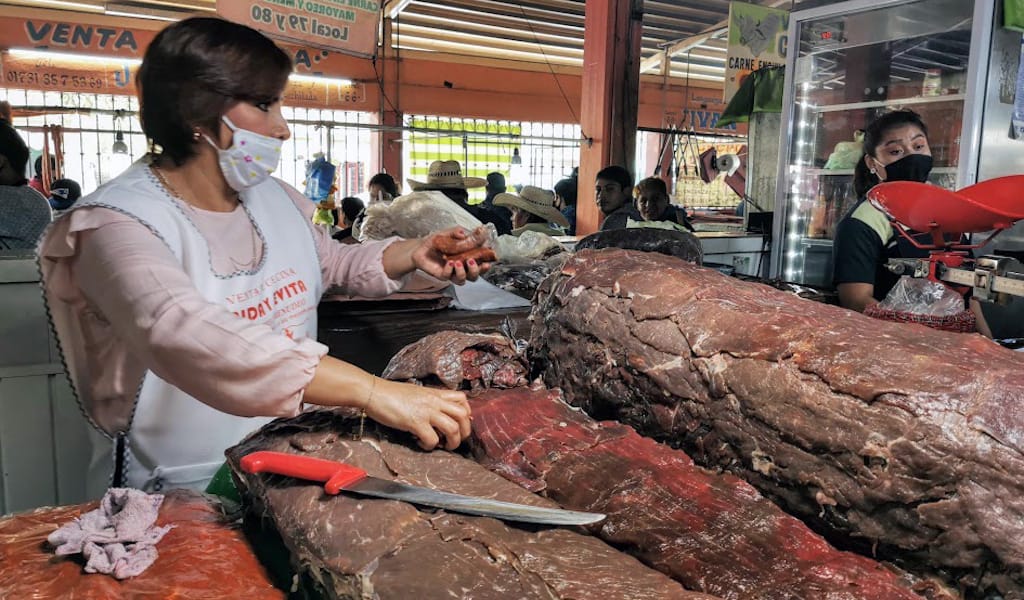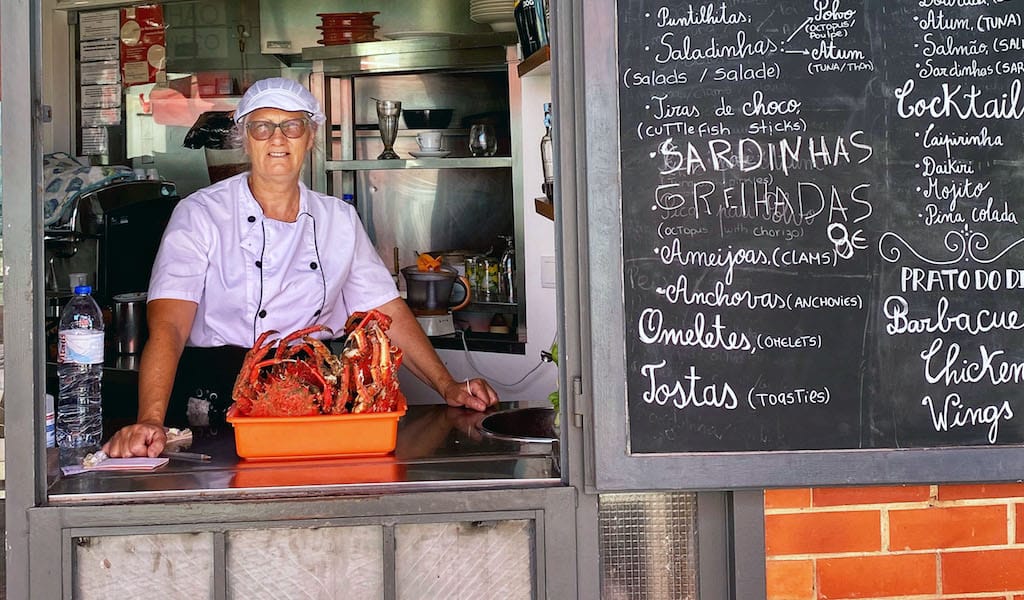A scenic highway wraps around the island city of Xiamen, allowing easy access to the mountainous interior and rocky coastline, but on the east coast the natural scenery gives way to man-made propaganda. Three-story-high characters facing the South China Sea dominate the skyline. As red as Mao’s Little Book, these towering characters proclaim “One Country, Two Systems, United China,” a stern reminder visible to the residents of Jinmen, a Taiwanese island less than 2 kilometers from the ancient port city’s shores. This sightline marks the shortest distance between the People’s Republic and the Republic, and while government policies may differ greatly depending on which side of the Taiwan Strait you call home, the food culture is remarkably similar.
Street food is king on both sides of the strait, and you can’t walk 100 meters without running into a hawker squeezing fresh juice out of tropical fruits or a grill master firing up griddles of spicy squid tentacles. Clustered around the ferry that links Jinmen and Xiamen, many of these food streets bill themselves as “Taiwan-style,” and you’ll see some of the island’s most touted after-dark delicacies lining the alleyways.
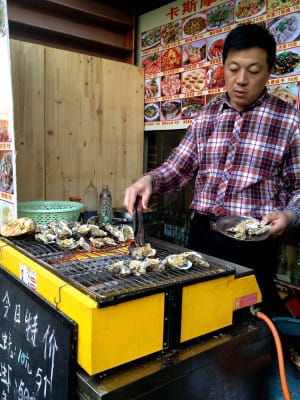 Seafood dominates and oysters are a cheap, local favorite, whether roasted with garlic sauce (烤生蚝, kǎo shēngháo) or fried in an omelet (蚵仔煎, ézǐjiān). The latter was voted in 2007 the snack that most represented Taiwan, and Xiamen’s rendition stays true to form, with the prized chewy texture (called “QQ” in Taiwan and pronounced just like the letter) and savory ketchup-based sauce slathered on top. Handmade fish balls (鱼丸汤, yúwán tāng) stuffed with minced pork and served in soup are another popular option. And stinky tofu (臭豆腐, chòudòufu) is also readily available, which is immediately obvious when you walk up to any food street. You can also find all of these eats on Gulangyu, a pedestrian island where Opium War leaders built colonial summer homes in the 19th century. A bit pricier thanks to the touristy environs, the snacks are worth the markup when you nibble them while strolling by crumbling Victorian homes.
Seafood dominates and oysters are a cheap, local favorite, whether roasted with garlic sauce (烤生蚝, kǎo shēngháo) or fried in an omelet (蚵仔煎, ézǐjiān). The latter was voted in 2007 the snack that most represented Taiwan, and Xiamen’s rendition stays true to form, with the prized chewy texture (called “QQ” in Taiwan and pronounced just like the letter) and savory ketchup-based sauce slathered on top. Handmade fish balls (鱼丸汤, yúwán tāng) stuffed with minced pork and served in soup are another popular option. And stinky tofu (臭豆腐, chòudòufu) is also readily available, which is immediately obvious when you walk up to any food street. You can also find all of these eats on Gulangyu, a pedestrian island where Opium War leaders built colonial summer homes in the 19th century. A bit pricier thanks to the touristy environs, the snacks are worth the markup when you nibble them while strolling by crumbling Victorian homes.
Xiamen’s offerings aren’t limited to dishes borrowed from Taiwan – just try their homegrown peanut sauce noodles (沙茶面, shāchá miàn), one of the city’s most famous dishes. To the curry, which stews for hours, you add your own ingredients from a mini buffet of fried tofu, boiled calamari, fried sausages, bean sprouts, boiled eggs, whole shrimp, pork liver and duck tendon. Tucked away by the dead end of an alley off the popular pedestrian Zhongshan Lu, Dazhong Shacha Mian does a deliciously rich version of this laksa-like soup. For dessert, try local peanut soup. It’s about as simple as a dish can be: peanuts are boiled until soft in water, then heaping spoonfuls of sugar are added. The most famous restaurant serving this dish is Huang Zehe, a canteen located right at the entrance to Zhongshan Lu. They also serve oyster omelets, shacha noodles and fish ball soup, but you can find better iterations at other stalls along the side streets.
The home of Nanputou Temple, Xiamen has a strong Buddhist culture and an innate respect for meat-free dining. Inside the temple’s walls is a vegan restaurant, which caters mostly to tourists. You’ll find more devotees just two blocks away at Da Fang. Named after a Buddhist monk from the Song Dynasty, the restaurant serves mock meats made of tofu, wheat gluten and mushrooms, like sweet-and-sour “pork” (糖醋里脊, tángcù lǐjǐ). Their “pure” vegetarian options are equally creative. Try the “Seemingly Boundless Sea” (佛海无边, fú hǎi wúbiān): snow peas, smoked tofu, crisp red pepper and wood ear mushrooms baked in foil.
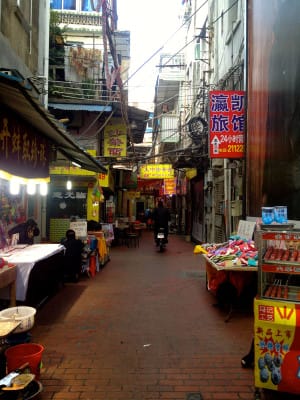 Xiamen is also home to the tenth-highest-ranked university in the country, and cheap student fare is available at all hours outside the campus’s west gate. While there are several excellent eateries to choose from, none holds a candle to Cai Jia Po. It’s technically a Shanxi-style noodle house that also serves Korean food, but it’s the pan-fried potstickers (哨子锅贴, shàozi guōtiē, for spicy pork and 海鲜锅贴, hǎixiān guōtiē, for seafood and pork) that keep the alfresco tables full. Springy white tofu simply scattered with salt and green onions (葱油拌豆腐, cōngyóu bàn dòufu) is a must-order side dish. If you sit down before lunch, you can watch the waitstaff make the beancurd fresh, tossing the ingredients into a giant 40-gallon drum.
Xiamen is also home to the tenth-highest-ranked university in the country, and cheap student fare is available at all hours outside the campus’s west gate. While there are several excellent eateries to choose from, none holds a candle to Cai Jia Po. It’s technically a Shanxi-style noodle house that also serves Korean food, but it’s the pan-fried potstickers (哨子锅贴, shàozi guōtiē, for spicy pork and 海鲜锅贴, hǎixiān guōtiē, for seafood and pork) that keep the alfresco tables full. Springy white tofu simply scattered with salt and green onions (葱油拌豆腐, cōngyóu bàn dòufu) is a must-order side dish. If you sit down before lunch, you can watch the waitstaff make the beancurd fresh, tossing the ingredients into a giant 40-gallon drum.
 August 30, 2021 CB on the Road
August 30, 2021 CB on the Road
In 2013, Anthony Bourdain and the Parts Unknown team arrived in Batumi, the capital of […] Posted in Tbilisi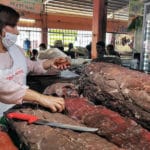 August 27, 2020 CB on the Road
August 27, 2020 CB on the Road
Cecina is a food for the road. In its most common form, the salted and dried meat can […] Posted in Mexico City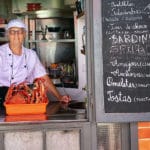 July 23, 2020 CB on the Road
July 23, 2020 CB on the Road
Olhão in the Algarve doesn’t have the picture-perfect scenery – the beautiful rocky […] Posted in Lisbon
Published on March 10, 2014
Related stories
August 30, 2021
TbilisiIn 2013, Anthony Bourdain and the Parts Unknown team arrived in Batumi, the capital of Adjara, to shoot the first segment of their Georgian adventure. The show’s producers invited Zamir Gotta, a Russian sidekick unfamiliar with the city, to join him. They visited a casino, strip club and mediocre restaurant for khashi, tripe soup, which…
August 27, 2020
Mexico CityCecina is a food for the road. In its most common form, the salted and dried meat can last for months, which explains why it was a main source of sustenance for travelers, sailors and soldiers in colonial Mexico. Nowadays, cecina is still known as a thin cut of cured meat – almost always beef…
July 23, 2020
LisbonOlhão in the Algarve doesn’t have the picture-perfect scenery – the beautiful rocky cliffs cascading into the sea – normally associated with the region. But this fishing town managed to avoid the overdevelopment that has plagued other fishing villages in the region, like Albufeira or Armação de Pêra, now cautionary tales of how not to…







































